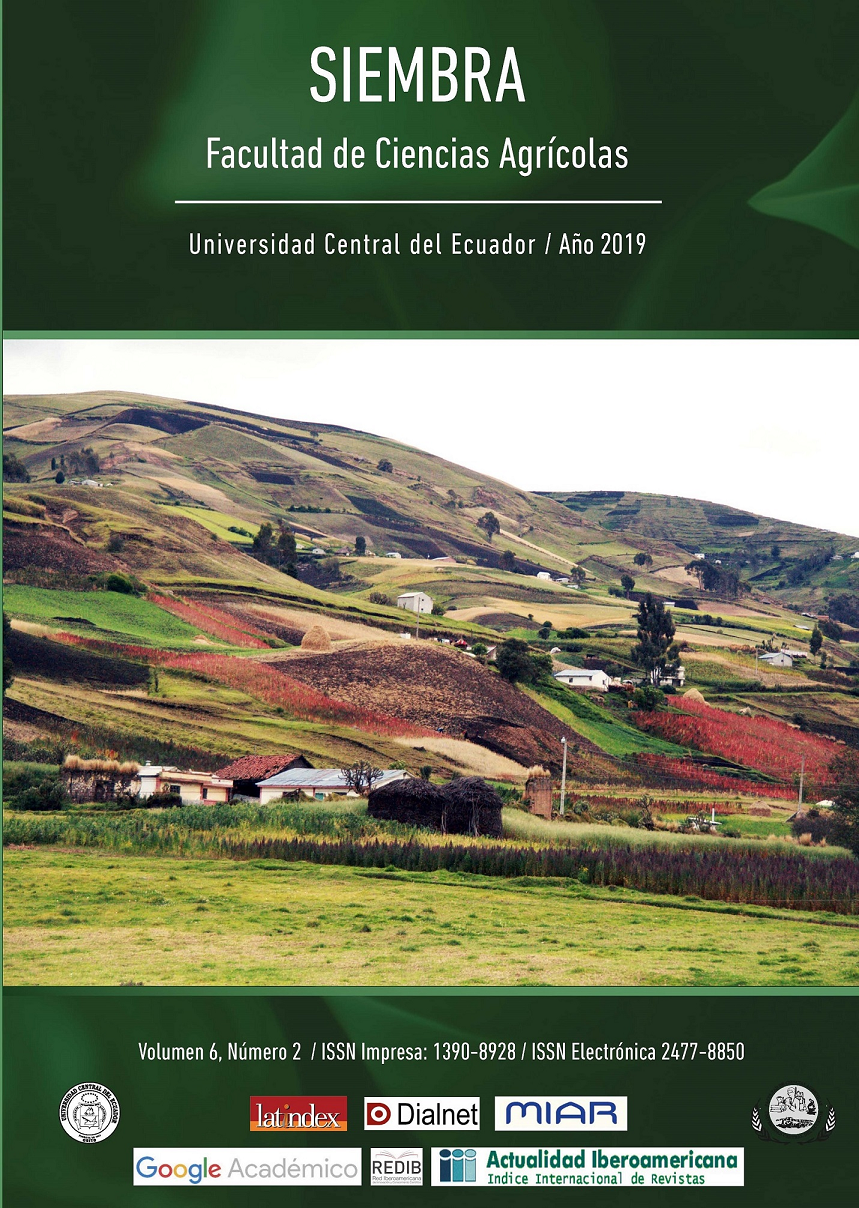Irrigation water distribution in the communities of the UCICMA – Imbabura
Main Article Content
Abstract
The distribution of irrigation water according to the cultivated area and the crop water requirements is important in the processes of socialization and debate to generate equitable distribution of water among the indigenous communities of Ecuador. The present study consisted of determining the maximum area of irrigation according to the crop water requirements and the discharge delivered to propose an alternative for irrigation water distribution among the 12 communities of the Unión de Comunidades Indígenas y Campesinos de Mariano Acosta (UCICMA). To calculate the crop water requirements, the following methodology was used: potential evapotranspiration (Penman Monteith), effective precipitation (SCS), crop coefficient (FAO 56), cultivation areas, planting dates and vegetative cycle (by surveys) and soil information (from studies conducted in the area). The main results of the study are: i) the continuous fictitious flow rate was about 0.58 l s-1 ha-1; ii) to irrigate the total area of the 12 communities a discharge of 950.55 l s-1 is required; iii) considering the discharge assigned of 360 l s-1, the maximum area that can be technically irrigated is about 619.96 ha. The main conclusion of the study is that the assigned discharge of 360 l s-1 will cover an irrigation area of 619.96 ha, corresponding to 37% of the potential irrigable area of the UCICMA.
Downloads
Metrics
Article Details

This work is licensed under a Creative Commons Attribution-NonCommercial 4.0 International License.
The authors who publish in Siembra know and accept the following conditions:
- Authors retain the copyright and grant Siembra the right of first publication of the work, under the Creative Commons Attribution License. Third parties are allowed to use what has been published as long as they refer to the author or authors of the work and its publication in this journal.
![]() This content is licensed under a Creative Commons Attribution-Noncommercial 4.0 International (CC BY-NC 4.0).
This content is licensed under a Creative Commons Attribution-Noncommercial 4.0 International (CC BY-NC 4.0).
- Authors maintain the copyright and guarantee Siembra the right to publish the manuscript through the channels it considers appropriate.
- Authors may establish on their own additional agreements for the non-exclusive distribution of the version of the work published in Siembra, acknowledging their initial publication in the same, such as in institutional repositories.
- Authors are authorized to disseminate their work electronically once the manuscript is accepted for publication.
References
Allen, R., Pereira, L., Raes, D., & Smith, M. (2006). Evapotranspiración del cultivo. Manual Técnico No. 56. Roma: FAO.
Corporación para el Desarrollo Social Económico y. Productivo Cia. Ltda., CIPRADEC. (2014). Plan de Desarrollo y Ordenamiento Territorial del Cantón San Pedro de Pimampiro. Pimampiro, Ecuador: GAD. San Pedro de Pimampiro.
FAO (2006a). Evapotranspiración del cultivo. Obtenido de: www.fao.org/home/es/
FAO (2006b). Evapotranspiración del cultivo. Guías para la determinación de los requerimientos de agua de los cultivos. Obtenido de: http://www.fao.org/3/a-x0490s.pdf
García, J. (1996). Redes colectivas, determinación de caudales. In Sistema de riego por aspersión (p. 45). Madrid: Centro de Estudios y Experimentación de Obras Públicas (CEDEX).
Instituto de Ecología y Desarrollo de las Comunidades Andinas, IEDECA. (2015). Diagnóstico de sistemas de producción de las comunidades de Mariano Acosta. Ibarra-Ecuador: IEDECA.
Instituto de Ecología y Desarrollo de las Comunidades Andinas, IEDECA. (2016). Estudio de dinámicas productivas de las comunidades de la UCICMA. Ibarra-Ecuador: IEDECA.
Instituto Nacional de Hidrología y Meteorología, INAMHI. (2013). Estaciones Meteorológicas. Obtenido de: http://www.serviciometeorologico.gob.ec/
Micucci, F., & Álvarez, C. (2005). El agua en la Produccion de cultivos extensivos. III. Impacto de las prácticas de manejo sobre la eficiencia de uso del agua. INPOFOS Archivo Agronómico, 8, 1-4.
Ortíz, R. (2011). Sistema de riego Podocarpus Yangana: requerimientos de riego y planificación del sistema. Loja, Ecuador.





